When you purchase through links on our website, we may earn a commission. Affiliate disclosure.
Thinking about converting your bike to electric, but don’t know where to start? In this Electric bike conversion kit guide, I will examine the different ways you can add electric assistance to your bicycle.
If you are willing to take the plunge, converting a bicycle to an electric assist can be an extremely rewarding experience. Not only that, but you can also make substantial savings when compared to buying a factory-produced e-bike.
Please note: The author of this electric bike conversion kit guide has 6 years of experience in this field and has converted 100s of bikes to electric assist.
DIY E-Bike vs Factory E-Bike
A typical entry-level mid-drive electric bike will cost in the region of £1600 ($2000). The brand new DIY mid-drive e-bike below cost me less than £900 ($1160) to build (including the cost of the new donor bike).
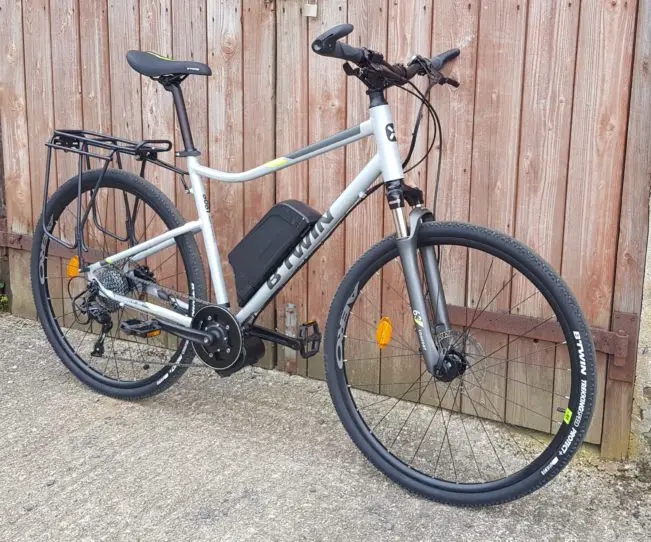
The donor bike I used in the above build is a Decathlon BTWIN Riverside 900, with a Tongsheng TSDZ2 mid-drive motor and 36v 13ah battery.
As you can see there are substantial savings to be made by converting a decent spec new bike to electric assist. If you are converting a bicycle you already own then the savings are even greater.
Let’s say you have an old Trek or Cannondale mountain bike sitting in the shed. Typically, a decent mid-drive conversion kit with a battery will set you back around £600 ($780). That’s a massive saving when compared with buying a factory-built mid-drive electric bike.
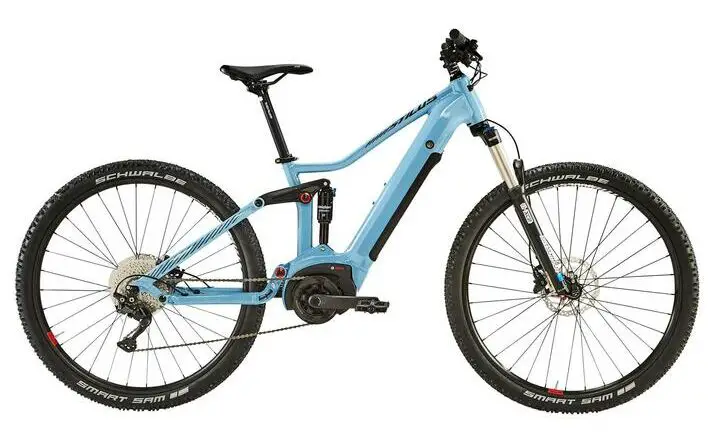
Converting a bike to electric isn’t for everyone though, and if you’re not mechanically minded, I would recommend purchasing a factory-produced electric bike or finding someone who can fit the kit for you.
You will also need to consider the fact that a retrofit electric bike conversion motor may not be as reliable in the long term as a Bosch or Shimano steps motor commonly found on factory-produced electric bikes.
Useful Links
- Best E-Bike Conversion Kits in 2023
- Hub Motor vs Mid-Drive: Which is Best?
- Building a DIY Electric Bike
- Electric Bike vs Conversion Kit
- Best Electric Conversion kit for a recumbent bike or trike
- Guide to converting your road bike to electric
To choose the right motor for your needs, you need to ask yourself what your intended use is going to be.
If you live in a fairly flat area, with only slight inclines, then a small geared hub motor should be more than adequate, but if you live in an area where there are relentless steep hills, then a mid-drive would be more suitable.
Ultimately, the decision you make will be influenced by your own needs. Both types of motors have their place on e-bikes but it is worth remembering that mid-drives in general are far more energy efficient than small hub motors.
Direct drive hub motors
The direct drive hub motor is the simplest form of electric bike propulsion: The outer shell of the hub is an integral part of the motor and has a big ring of powerful magnets fixed to it.
When the motor runs, it drives the wheel directly (that’s where the name comes from). Put simply this means that the wheel is a motor with the shaft fixed in place so that the body of the motor (the outer hub shell, and thus your wheel) spins instead of the shaft.
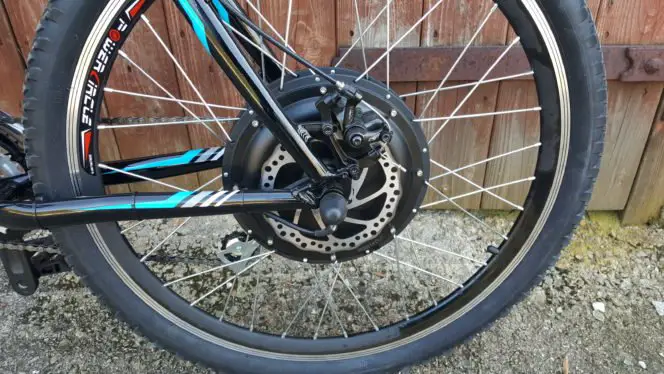
It is a simple design, but comes at a cost – the motor needs to be quite big and heavy to produce enough power. A smaller motor spinning slowly wouldn’t produce enough torque, and the speed you want your wheel to turn is relatively slow, so the motor needs to be as big as possible to produce torque at low speeds.
On the positive side, direct-drive hub motors tend to be cheap and reliable plus they can handle a lot of power. So if you are looking for a high-performance electric bike on a budget then a big hub motor may be the way to go.
Geared Hub Motor
Small geared hub motors are a lot more efficient than direct drive motors. The motor case is connected to the stator through a planetary gear reduction system. For every rotation of the case, the motor inside spins many times faster. This allows the motor to work at higher (and more efficient) speeds, while still allowing the wheel to spin at a slower driving speed.
Another great benefit to using a geared hub motor is there is practically zero pedalling resistance if the motor is switched off or runs out of power – you can pedal like on a normal bicycle.
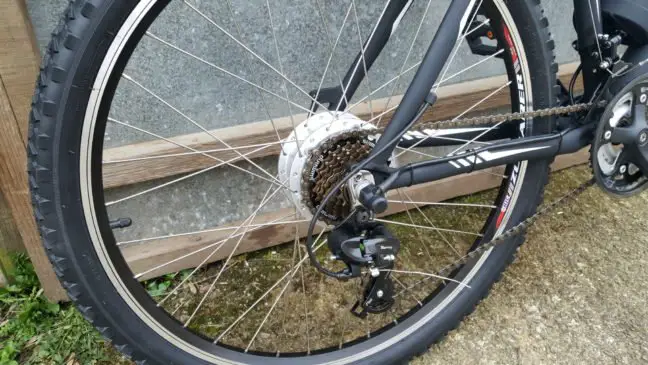
Geared motors are usually maintenance-free, but if you do a lot of hill climbing it is likely the nylon planetary gears will wear over time. Thankfully these are cheap and relatively easy to replace.
Check out the best hub motor conversion kit on eBay
Front Hub Motor vs Rear Hub Motor
Front-wheel Electric bike conversion Kit
There are various pros and cons of fitting a front hub motor vs a rear hub motor. When it comes to electric wheels, front hub motors are usually more straightforward to fit. The main reason for this is you do not need to worry about swapping over gear cassettes or freewheels.

It should be noted, that the best option for a front-wheel electric conversion would be a small, geared hub motor. The reason for this, is they are compact, lightweight and produce reasonable torque.
Larger direct-drive front-wheel electric bike kits are available. They are generally cheaper and more powerful, but the extra size of the motor can make it difficult to fit onto bikes that have disc brakes. They are also considerably heavier and less efficient.
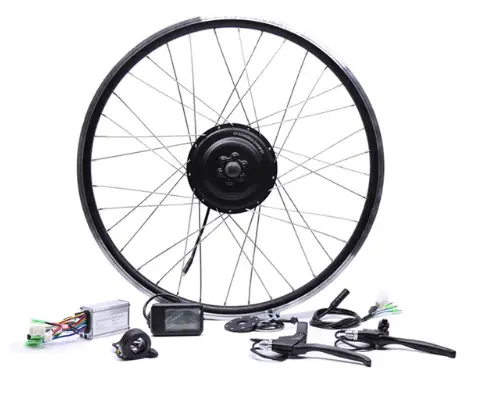
Another plus with a front hub motor is when you are using the pedal assist, the bike is effectively being driven by both wheels. Whilst the electric front wheel is giving you help, you are putting power through the rear wheel by pedalling.
Electric front wheels are not particularly good for off-road riding, as the powered wheel can tend to spin on rough ground, particularly when climbing steep hills.
Rear Wheel Electric Bike Conversion Kit
A rear-wheel electric hub motor is usually the preferred way to add electric assist to a bicycle using a conversion kit. Changing the rear wheel involves a little more work, specifically removing the gear cassette (or freewheel), you will need a special tool for this job.
As far as riding is concerned, the motor is pushing as opposed to pulling you (as with a front motor). Generally, a smaller geared rear hub motor will look a lot more discreet.
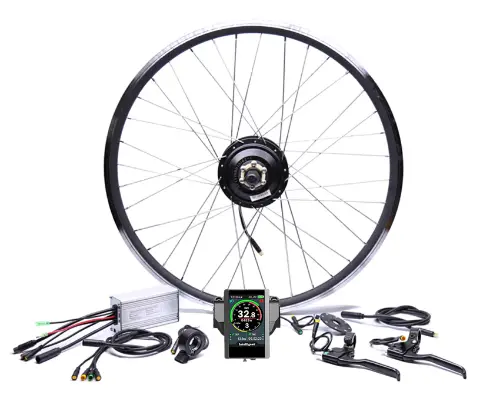
Another bonus with rear hub motors, is they are a lot better for use on rough ground. All of the rider weight is concentrated on the back wheel, there is much less of a problem with wheel spin.
The only real downside with this setup is replacing an inner tube in the event of a puncture can be time-consuming. I always recommend a good puncture-resistant tyre like a Schwalbe Marathon Plus to greatly reduce this risk.
Mid-Drive Motor
The mid-drive motor is the preferred drive system of more expensive e-bikes. These types of motors are by far the most efficient and they also produce much more torque than hub motors.
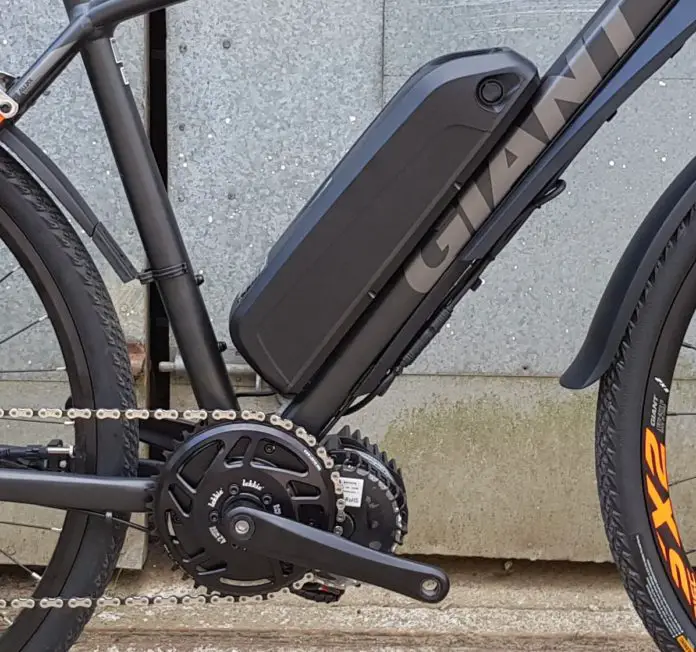
Fitting this kind of motor can be tricky for the inexperienced, as the bicycle’s bottom bracket needs to be removed to facilitate installation. Once this job has been done, the rest is fairly straightforward. It is important to remember that most mid-drive kits are only compatible with standard threaded bottom bracket shells 68 mm-73 mm wide and approximately 33.5mm in diameter.
When installed correctly, a mid-drive system will give your bike the look and feel of a more expensive e-bike.
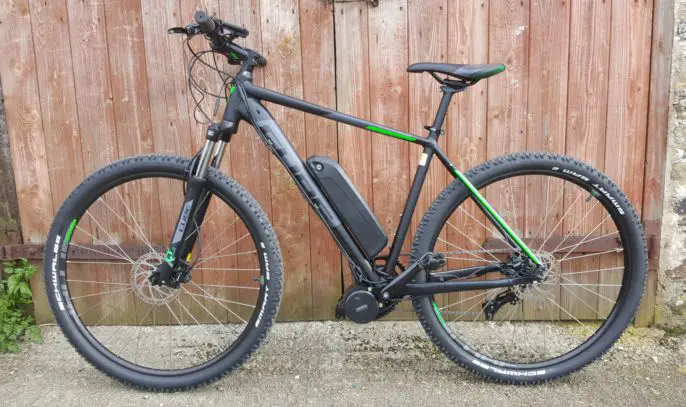
The only downsides to mid-drive motors are increased pedalling resistance when the motor is switched off and periodic maintenance (such as tightening the motor). You will also be limited to a single chainring on the front.
Mid-Drive vs Hub motor
Taking into account all of the above information it boils down to your budget and the kind of riding you plan on doing.
In my experience, small hub motors are usually a lot less hassle than mid-drives in the long term. Another thing to consider is pedalling resistance. Both the mid-drive and direct-drive hub motors produce a significant amount of resistance with the motor off.
Mid-drives are much better at hill climbing, a 250w Bafang BBS01B will produce nearly 100% more torque than a geared hub motor equivalent.

Hub motor kits have more of a ‘DIY look’ about them, there will be an external controller (usually in a frame bag), an external pedal assist sensor and lots of wiring to tidy up. Mid-drive motors definitely provide a cleaner and neater-looking finished product.
Choosing the Right Battery
Battery choice is important because it will determine the kind of range you can expect from your electric bike.
First and foremost you will need a battery of the right voltage. Most kits are 36v or 48v, the 48v kits will usually take 52v batteries but this can in some cases compromise reliability. There are some motor controllers available that will take either a 36v or 48v battery but you will need to double-check this first before making your purchase.
The Ah (amp hour) spec provides a measurement of battery capacity. In other words, it is an indication of how much energy can be stored by the battery. For example, a 36v 13ah battery (36v x 13ah) will have a total energy capacity of 468Wh (watt hours) – using a constant 20Wh per mile would give a range of approximately 23 miles. In real-world riding, this figure could be much greater or lower depending on the power level used, rider weight, the kind of terrain (flat or hilly) and wind direction.
The other thing to consider is the size/style of frame you will be fitting the battery. Normal hybrid or hardtail mountain bikes of 18″ frame and above usually have plenty of space, but when you get down to 16″ frames, things can become a lot tighter.
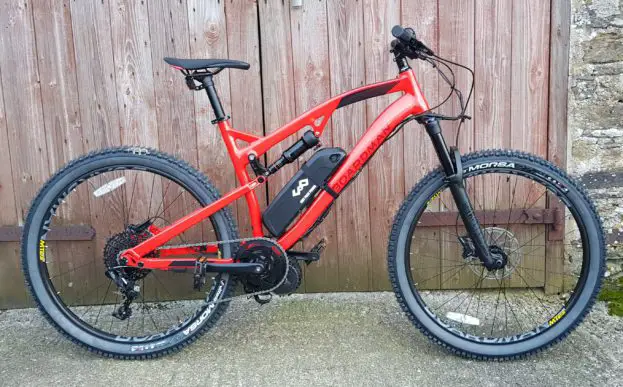
If you have a full-suspension mountain bike then mounting a battery in the frame can be practically impossible (depending on the bike). Ladies framed bikes and step-through bikes are usually better suited to a rear rack-mounted battery.
You should take measurements of your frame triangle before purchasing a battery. It is also worth noting that some battery packs do not align particularly well with the bottle holder threads on the frame. If this is the case, you may need to drill and riv-nut an extra hole or two.
For more information on e-bike batteries please check out my article ‘electric bike batteries explained’
Conclusion
If you are looking for a bit of help with hills but want to pedal under your own steam for a lot of the time, then a small geared hub motor would be the way to go. If you are looking for a bike that will be able to tackle very steep climbs with ease, then maybe a mid-drive would be a better option. Either way, converting a bike to electric can be both challenging and rewarding.
Most people don’t choose to convert a bike because it’s the ‘easy option’. But, they’re looking for something unique to them. Or, they have an old bike with sentimental value. If you’re up for the challenge, then I’d say give it a go! But, please remember to check the e-bike laws in your country of residence.
Compare prices on over 40 popular e-bike conversion kits.
Thank you for taking the time to read this article, and we hope you have found this electric bike conversion kit guide useful. If you need any further help or advice on choosing a conversion kit, please leave a comment below.

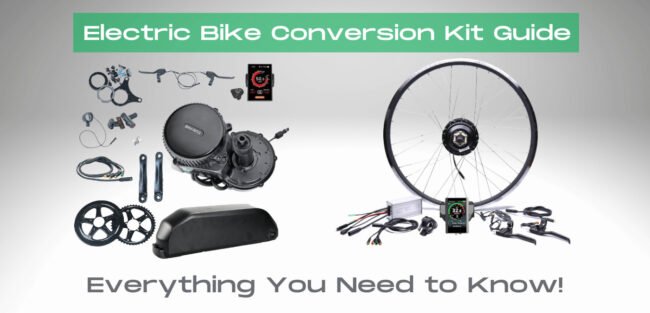
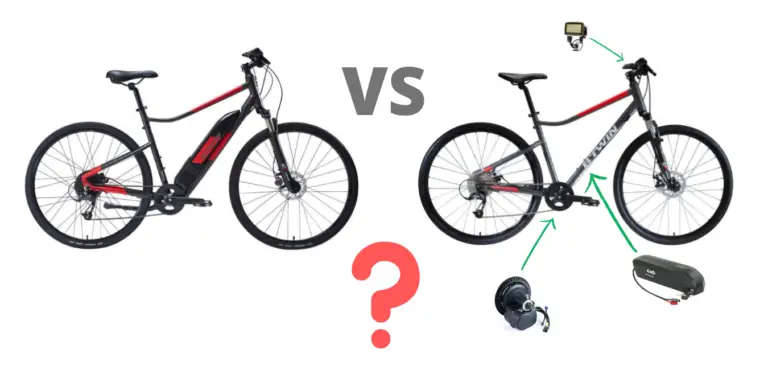
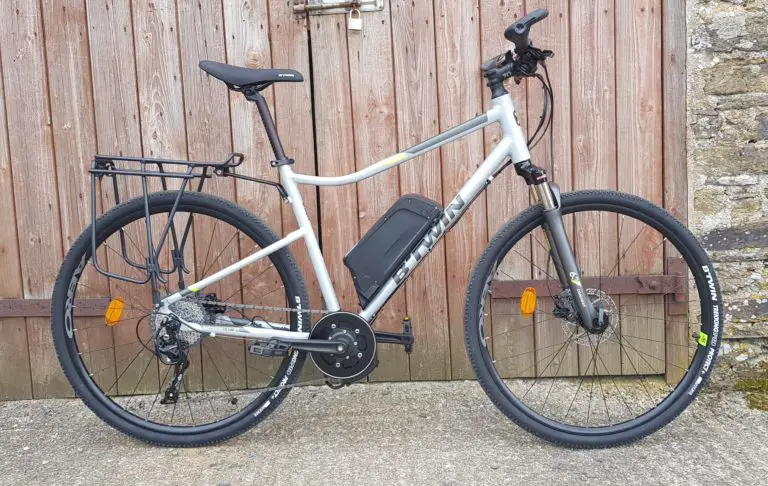
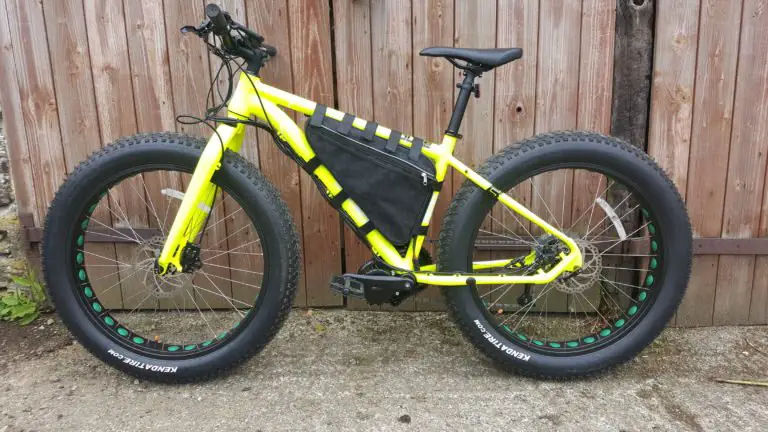
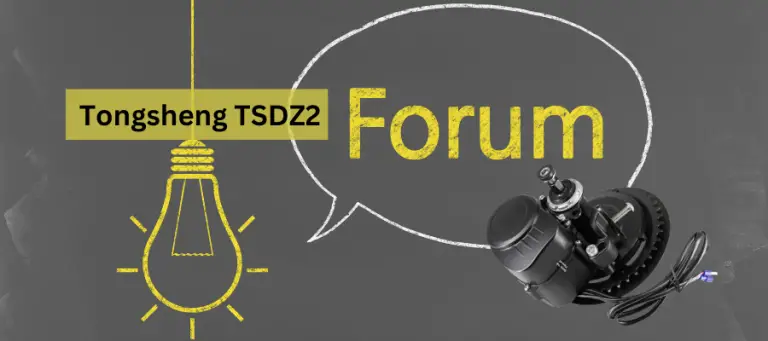
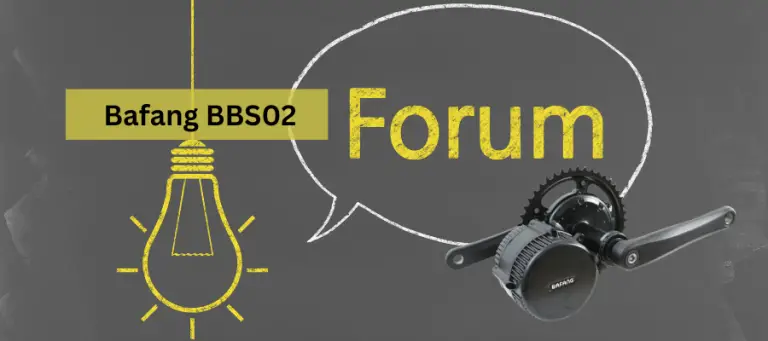

Hello Tony,
thank you for your great web! And others for discussion.
Would you please help me a little.Can you recommend a combination for specific use:
rear, middle or front motor – some as light as possible (I was looking on Bafang H600 but could not find any in Europe – this is 2kg
https://bafang-e.com/en/products/motors/hr-series/h600-1/
Most important that it is for yo 30kg weight boy 10 ys old (with muscular dystrophy at begining phase in shame)
I have for this very light jr. bike with 9speeds casette, V brakes, 24´´ rims
It is 8,6kg so thats why i ma looking lightest version….
it should be 250W, 36V with pedal pas ( I do not expect using it with power throthle or with “cruise” function (but 6km/h for taking in hands would be nice but only if you do not need throtle for it)
So I think I do not need brakes (with sensors)
It should go easy also when you switch motor off or you are out of the battery
– controll box – some small one and quiet (Sinwave?)
– any water resistancy would be nice
For battery ve are using “hoverboard packs 4,4Ah 36V” wich is very cheep and we ahave about 5 of them on our adult backpack and changing them during the ride…
Thank you very much and regards from Prague
Marek
Hi Marek,
For lightweight and simplicity I would look at the kits from Swytch or Cytronex. Both of these use small front hub motors and are very lightweight (under 3.5kg including battery). As both of these kits come with a battery, I’m not sure if it’s possible to use your own, but it would be worth asking.
I’ve checked availability of the Bafang H600, and it only seems available from China at the moment. The mid-drive motors like Bafang are very heavy, with the BBS01B 250w weighing in at 4.2kg just for the motor and the Tongsheng TSDZ2 weighing 3.6kg. Plus, installation can be problematic with limited (or none) clearance for gear cables etc.
The front motor kits available from Yose Power, are very affordable and reasonably lightweight, and they can be used with your own battery. But, they do produce an audible whine when in full power mode (like most small hub motors).
I hope this helps, please let me know if you have any more questions.
Regards,
Tony
Hallo Tony,
super diese Informationsvielfalt. Vielen Dank für Deine sicher nich kleine Mühe das Alles zusammen zu tragen und auch noch in Worte zu fassen. Da ich nun neugierig geworden bin, möchte ich auch einen Umbau wagen. Welcher Bausatz wäre nach Deiner Meinung der Richtige für ein Scott Scale 29 Elite MTB. Schon mal vielen Dank für Deine Antwort.
Viele Grüße
Norbert
Hi Tony
First of all, congratulations for the site and its content.
I’ve read several articles and realized that for what I want the mid-engine kit will be the most suitable.
Now my doubt is between Bafang and Tongsheng and what model/power.
I have a decathelon bike, a Riverside 500 that I swapped the suspension for a carbon fork. I like to do routes between 30 and 60 km on mixed routes; secondary roads, cycle paths, gravel and some off-road, both on flat and on gentle to moderate slopes.
For this purpose, what do you recommend in terms of engine, taking into account the difference in assistance in the paddle between the 2 engines and which battery will be the most recommended?
Thank you very much in advance for your attention
Hi Fernando,
Thank you for your compliments, much appreciated.
Regarding your Riverside 500, I would personally go for a Tongsheng TSDZ2. I converted a Decathlon Riverside 900 a couple of years back using this motor in combination with a 36v 13Ah battery and thoroughly enjoyed riding it. I covered nearly 1000 miles on it before selling it on again.
There are a few things to consider:
1. The TSDZ2 uses a torque sensor and feels more natural pedalling, but it doesn’t feel as powerful as the Bafang equivalent. I used to regularly climb 15% hills without problems, but you still needed to add a fair bit of effort.
2. There is more to go wrong on the TSDZ2 – Blue nylon gear can fail (easy to change) and sometimes the torque sensors can cause problems (I didn’t experience these problems).
3. If there are any cables routed underneath the bottom bracket shell, you will need to re-route them as there is no clearance from the motor.
4. It’s not straightforward to program the TSDZ2 (when compared with the Bafang)
If it’s power you want, then the Bafang would be the motor to choose. If you want the motor to enhance your ability in a natural way, then the TSDZ2 would be better.
Regarding battery, I found the 36v 13Ah Hailong case battery would give a range of around 100km using mixed assist.
I hope this helps, if you have any more questions, please let me know.
Regards,
Tony
Hei
Tarkoitatko,ettei Bafang-moottoria voi asentaa,eikä se sopisi jalkajarrulliseen pyörään (mainitsit lasinalusjarru?) ollenkaan vai sitä,että sen jarrujohdotus on vain jätettävä kytkemättä? Etupyörässä olevaan V-jarruun sitten tulisi jarrujohdonkytkentä ja kahva.Oma pyöräni on Solifer 28″ ns.mummomallinen jossa on n.46 tai 48 cm matala runkokorkeus (en muista tarkasti kumpi) peruspyörä,johon tehtaan edustajan toimesta takapäähän vaihdettiin kiekko,jossa on Shimano Nexus 3 napavaihdetta ja jalkajarrut: SG-3C41 Hub w/Coaster Brake,jotka kaikki ovat siis takapyöräni “kapassa” sisällä.Olen katsellut 250W 36V Bafang-moottoreita,ettei tarvitsisi katsastaa ja saisin ajella pääasiassa pyöräteillä.Sopivat tarakalliset akkusetit vain vaikuttavat olevan lähes kaikilta myyjiltä nyt loppu.
Ketjuratas ja ketjut myös epäiröityttävät,kun en ole muita vaihtoehtoja joutunut aiemmin tutkimaan.MInulla on n.30 piikkinen ketjua kuljettava ratas keskiön kohdalla ja Bafangeissa on valittava ratas,jossa pienimmässsä merkintä on 44T.Takapyörässäni ratas on 20-piikkinen.MInulla on ns. “peruspyörän” ketjutkin siis käytössä.Eräs myyjä vastasi,että voisin käyttää omaa alkuperäistä ratastani ja ketjuakin eli se olisi siis vapaasti valittavissa minkä haluan.Pitääkö tämä tieto paikaansa?
Kiitos.
T.Viol K
Moi,
Minulle tuttuja vuoristojarruja käytetään kääntämällä polkimia. Tämä ei olisi mahdollista Bafangilla moottorin sisäisen vapaapyörän vuoksi. Minulla oli jokin tapa muokata vapaapyöräjärjestelmää moottorin sisällä, niin se voitiin tehdä.
Hi Tony, I looked at your website and bought a bafang bbs02b 750W Motor at a retailer you recommended to retrofit my Barracuda Colorado 27.5″ Mountain Bike. Hope it’s worth it.
Hi Kevin,
You should be fine fitting a BBS02B to the Baracuda Colorado. I’ve just checked the spec and it has a regular threaded bottom bracket and standard (non-boost) rear hub spacing. Just remember that when you remove the bottom bracket, both sides unscrew towards the front on the bike (chainring side unscrews clockwise). You might need a long breaker bar to get the leverage to remove the bottom bracket, as they can be a bit tight.
Let me know how it goes.
Cheers,
Tony
Hi Tony
Thought I would give you an update on the conversion of the Pashley Picador trike. First problem was that the Pashley front forks are not wide enough to allow the fitting of a disc brake on the Yose Power motor. I initally tried a 160mm dia disc, then a 140mm disc but there was insufficient clearance for either. The front forks just neaded opening out slightly as the Yose Power axle is larger than the Pashley. I solved the brake problem by mounting another caliper brake infront of the existing one. The Pashley caliper brake has a long drop amd the additional brake needed to have an even longer drop. The only brake I found with a long enough drop was the Ztto 70-90mm which is widely available on eBay. I couldn’t find a seller offering the option to purchase a single brake so had to purchase a pair. The other problem I encountered was that while the magnet disc of the pedal assist sensor just fitted the gap between the pedal crank and the bottom bracket set was so tight that the magnetic disc rotated at a much lower speed than the pedals. A grinder was used on the bottom bracket set, with care, to very slightly increase the gap – problem solved. The battery, a Yose Power 13Ahr rack battery was mounted on top of the rear basket. I had thought that cable lengths might be a problem but that proved unfounded. So the conversion was easy other then the provision of another brake to replace the Pashley drum. So far we haven’t done many miles on it but as the weather improves we hope to change that. I certainly think the Yose Power conversion is very worthwhile. Hope this encourages others with a Picador to convert to epower. Regards. Eric
Hi Eric,
Thanks for the update, much appreciated. Glad the conversion was reasonably straightforward. Please feel free to leave a review over on the Yose Power review article.
Regards,
Tony
hey tony!
i have tried both bike here in vancouver. the rad power and ncm leon cycle.
i prefer rad. the controller gives me constant assist i can pick. from 25% to 50 to 75. is this a watt type controller?
the other ncm bike has speed cut off which is annoying. in pas 2 it cuts off assist in 15kmh. making it so hard to paddle on my own.
do you know what the rad power type of controller is called? and where can i get this type of kit? would like to see a review of this one? thanks!
I decided to purchase the BAFANG BBSO2B 48V-750watt, I’m going with the 48v-17.5ah battery. Can you recommend where to buy one and which model/manufacture. I’m in Toronto and thinking Amazon has the best deal but not sure it quality.
Hi Joe,
I would try Junstar on eBay, they ship from Canada and have lots of positive feedback. Here is a link to their BBS02B 750w listing with 48v 17.5Ah battery. I’ve previously purchased direct from them in China without any problems.
Hallo Tony,
Fantastische site met veel informatie.
Ik heb net een tweedehands MTB Trek Roscoe 8 met 27,5+ banden gekocht.
En ik wil de Trek elektrisch maken met Tongsheng TSDZ 2 middenmotor.
Maar de motor past niet doordat de chainstays te snel te breed uitlopen. Daardoor kan ik de trapas van de Tongsheng niet ver genoeg doorsteken. Ik hou geen schroefdraad over aan de linkerkant.
Is hier een oplossing voor te bedenken?
Je kunt bijv. spacers toepassen, maar dan is de trapas waarschijnlijk niet lang genoeg.
Graag jouw visie.
Groet, Rob
Hallo Rob,
Helaas is de Trek Roscoe 8 niet echt geschikt vanwege de boost achternaafafstand in combinatie met de 73 mm trapasbehuizing. Als je de motor al hebt, kun je een trapasverlenger (83 mm-100 mm) aanschaffen. EcoCycles heeft hier meer informatie over. Je zou aan beide zijden afstandhouders nodig hebben, maar het eindproduct zou een zeer brede q-factor hebben. Ik hoop dat dit helpt.
Groeten,
Tony
Hallo,
Bedankt voor je reactie.
De Trek Roscoe (2021) heb ik een week bij een particulier tweedehands gekocht. De motor heb ik niet gekocht, maar wel gepast op de Trek. En dat lukte niet. Vandaar mijn vraag aan jou of er een oplossing voor is.
Inderdaad wordt de Q-factor een dingetje. Ik weet nog niet wat ik ga doen.
Inruilen voor een E-bike bij mijn LBS?
Even denkpauze nemen.
Groet, Rob
En past een Bafang middenmotor wel op de Trek Roscoe 8 (27,5 +)?
De Trek Roscoe 8 maakt gebruik van een SRAM Powerspline trapas met schroefdraad, zodat de motor past. Het enige probleem dat ik kan zien, is de 141 mm boost achternaafafstand – hierdoor kan de liggende achtervork de motorbehuizing hinderen. Je hebt geen ruimte voor spacers op de 68 mm-73 mm-versie en de 100 mm BB-versie zal een zeer brede q-factor maken.
Hallo Tony,
Past een Bafang middenmotor op de Trek Roscoe 8 (27,5+)?
En zo ja, moet ik aanpassingen doen, zoals spacers of trapasverlengers?
Graag jouw visie?
Groet, Rob
Hallo Rob,
Zie mijn reactie hieronder. De Bafang past, maar heeft een bredere as nodig – de volgende maat groter is 100 mm. Dit zou passen, maar spacers zijn vereist en het zal de q-factor naar mijn mening te breed maken. Bovendien zult u waarschijnlijk problemen hebben met het draaien van de motor in het trapashuis. Een ander probleem zal zijn dat de kettinglijn goed af zal zijn en het zal de schakelkwaliteit zodanig in gevaar brengen dat je niet het volledige versnellingsbereik aan de achterkant kunt gebruiken. Ik zou een fiets aanraden met een non-boost naaf.
Groeten,
Tony
Hallo, ich überlege ein Flux V220 auf Elektroantrieb umzurüsten. Wenn würde nur ein Vorderradantrieb in Frage kommen, da ich hinten die Nabenschaltung behalten möchte und ein Mittelmotor in dem Fall vorn und relativ hoch wäre. Ich weiß aber nicht, wie ich den Akku am Besten befestige- es gibt keine Aufnahme für einen Flaschenhalter. Eventuell könnte ich den Akku “über Kopf” mit Rohrschellen am Rahmen befestigen? Der Kontroller sollte auch in das Akkugehäuse, da weiß ich nicht, welche Akkus und Kontroller dafür geeignet sind. Gibt es da Optionen?
Hallo,
Yose Power bietet ein Vorderrad-Umrüstkit an, das einen Akku mit integriertem Controller enthält – hier ist der Link. Wenn Ihr Liegerad ein 20-Zoll-Vorderrad hat, können Sie das Yose Power-Kit kaufen und den Motor in eine geeignete Felge schnüren lassen. Bezüglich der Platzierung der Batterie ist es auf den Fotos schwer zu erkennen, aber ich würde sagen vielleicht hinter dem Sitz, oder lassen Sie möglicherweise eine Montageplatte herstellen und platzieren Sie sie unter dem Sitz. Diese Batterien sind (Länge) 360 mm x (Höhe) 110 mm x (Breite) 90 mm.
Grüße,
Toni